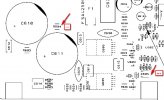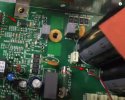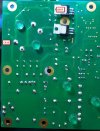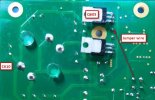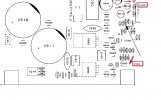beavernuggetz
Member
- Joined
- Sep 21, 2023
- Messages
- 36
- Likes
- 2
Hello everyone,
I am working on 4 of these JBL amps for a DJ friend of mine. The initial issue was of course some sort of power surge fried some components on the board. This is the first one I'm working on.
Pictures and videos can be seen here @ MyGoogleDrive. If this is not allowed, please let me know.
On the bottom, the GB20B60PD1 IGBTs were blown to pieces and on top there were lots of SMD components which are near the IGBTs were also shorted.
I gathered the list of dead components and ordered replacements from DigiKey and Mouser.
Couple of issues with the parts. First. the GB20B60PD1 IGBTs are no longer manufactured so watched a few YouTube videos where a guy used IKP20N60TXKSA1 instead; ordered them since the specs match closely with the originals. Second, there are 4 high voltage transistors labelled MPSW42 (Q607-610; see schematic attachment) which are no longer manufactured, used MPSA42 instead because they are nearly identical. The rest of the parts were in stock including TL494, FAN7380, J1 & K1 transistors, etc.
Once all the parts were replaced but without having the TL494 (Switching Controller) & FAN7380MX (High-Side Gate Driver IC) connected, turned the amp on, measured 17 volts between SMD resistor R604 and the U1J diode as shown in one of the videos. Believing the voltage was okay, soldered the remaining components but the issue described in the first video came up; when powering up the amp, the front LEDs come on and after about 20 seconds the power light (blue one) starts blinking frequently and a clicking noise can be heard. There are no shorts because the amp is connected to a lamp current limiter; have tried connecting it directly to an outlet with the same result.
Does anyone know what this symptom means and what could be the cause? Could it be the parts which had to be substituted causing this?
All feedback is welcome and will be highly appreciated.
I am working on 4 of these JBL amps for a DJ friend of mine. The initial issue was of course some sort of power surge fried some components on the board. This is the first one I'm working on.
Pictures and videos can be seen here @ MyGoogleDrive. If this is not allowed, please let me know.
On the bottom, the GB20B60PD1 IGBTs were blown to pieces and on top there were lots of SMD components which are near the IGBTs were also shorted.
I gathered the list of dead components and ordered replacements from DigiKey and Mouser.
Couple of issues with the parts. First. the GB20B60PD1 IGBTs are no longer manufactured so watched a few YouTube videos where a guy used IKP20N60TXKSA1 instead; ordered them since the specs match closely with the originals. Second, there are 4 high voltage transistors labelled MPSW42 (Q607-610; see schematic attachment) which are no longer manufactured, used MPSA42 instead because they are nearly identical. The rest of the parts were in stock including TL494, FAN7380, J1 & K1 transistors, etc.
Once all the parts were replaced but without having the TL494 (Switching Controller) & FAN7380MX (High-Side Gate Driver IC) connected, turned the amp on, measured 17 volts between SMD resistor R604 and the U1J diode as shown in one of the videos. Believing the voltage was okay, soldered the remaining components but the issue described in the first video came up; when powering up the amp, the front LEDs come on and after about 20 seconds the power light (blue one) starts blinking frequently and a clicking noise can be heard. There are no shorts because the amp is connected to a lamp current limiter; have tried connecting it directly to an outlet with the same result.
Does anyone know what this symptom means and what could be the cause? Could it be the parts which had to be substituted causing this?
All feedback is welcome and will be highly appreciated.

